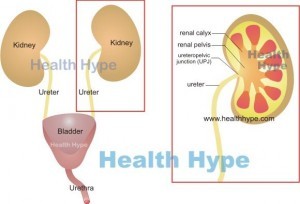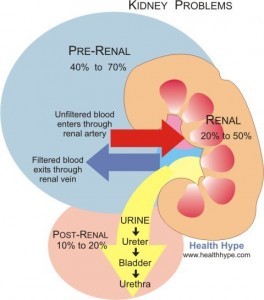Strained Kidneys – Meaning, Symptoms, Diet and Treatment
Our kidneys are working 24 hours a day to filter wastes and toxins from the bloodstream, control the blood pressure and manage the fluid volume in the body. These are only some of the functions that our kidneys are constantly managing. Despite having two kidneys, there are various diseases that can compromise kidney function and eventually lead to kidney failure. One kidney may be able to work efficiently and compensate for the other failing kidney, but in time the remaining kidney may also be affected. It is therefore important to know what you should and should not do for kidney health.
Meaning of Kidney Strain
The term kidney strain is a not a medical term as such but rather a common term to describe undue stress or reduced function of the kidney(s). Kidney strain is sometimes seen as the early stage of kidney problems, before the kidney function ceases almost entirely (kidney failure). This can be acute or chronic. In acute kidney failure there is a rapid decline in kidney function but usually the kidneys can return to normal function. In chronic kidney failure, the decline is more gradual and irreversible.
We all strain our kidneys several times in life. For example taking too much of certain pharmaceutical drugs can strain the kidneys but a healthy kidney can quickly recover once these drugs are stopped. We may not necessarily have reached the point of kidney failure in this case but the kidney function was sufficiently affected to be noted on laboratory tests and possibly even give rise to some symptoms. Unfortunately most of us will never know when we are straining our kidneys because mild kidney strain and even mild to moderate kidney disease often causes no symptoms.
Glomerular Filtration Rate (GFR)
The main way that the kidney function is assessed is by the glomerular filtration rate (GFR). This is the kidney’s ability to filter blood. Normally the kidney filters liters of blood every hour to extract wastes, toxins and other substances that are not needed by the body. These substances along with water are passed out as urine. However, when the glomerular filtration rate declines, this means that the kidneys are not doing the job of filtering blood as effectively as it should.
The GFR is assessed by taking a blood sample and measuring the blood creatinine levels along with other substances. There are different formulas that are used to reach the GFR value and these values may depend on several factors including age, gender, height, weight and ethnicity. Normal GFR ranges from 90 to 120 mL/min/1.73m². However, these levels can vary and GFR does decline with advancing age. An abnormal GFR indicative of chronic kidney disease is where the reading is below 60 mL/min/1.73m², or between 60 to 90 mL/min/1.73m² where other indicators of kidney disease are elevated.
Other laboratory tests may also be done to assess the levels of different electrolytes like sodium and potassium in the blood, waste substances like urea and creatinine in the blood, and levels of protein in the urine. All of these substances can be used as an indicator of kidney function and kidney disease. If the level of one or more of these substances are elevated, even when the GFR is above 60 mL/min/1.73m² but less then 90 mL/min/1.73m², indicates kidney disease.
Kidney Strain Symptoms
Any strain on an otherwise healthy kidney is unlikely to produce symptoms. In other words your kidneys may be undergoing strain but you will not know it for months or even years until advanced kidney disease sets in. Therefore tests like the glomerular filtration rate (GFR) are so important in identifying kidney dysfunction at an early stage, well before symptoms arise. It is also possible to be straining the kidneys without it causing any abnormality in kidney function. However, ongoing strain will take its toll and eventually lead to kidney disease.
The symptoms that may eventually become evident depend on whether it is acute or chronic kidney disease, and whether you have already reached end-stage renal disease. It can also vary to some extent by the cause of kidney disease. For example, the symptoms of kidney disease caused by prescription medication like lithium and analgesics may differ from that of a kidney infection. Some of the common symptoms include:
- Edema (swelling), particularly of the legs.
- Proteinuria (protein in the urine)
- Hematuria (blood in the urine)
- Kidney pain (only in some disease like an infection)
- Blood pressure changes, particularly hypertension.
Diet and Lifestyle
Dietary and lifestyle management is an essential component in the treatment of kidney disease. It is just as useful if there is an indication of kidney strain or suspected strain of the kidneys despite a normal GFR and urinalysis. Your doctor may advise that you:
- Reduce your sodium intake and limit the intake of other electrolytes as well like potassium and phosphorus.
- Decrease your protein consumption.
- Do not drink excessive amounts of fluid
Diabetics may also be advised on a low GI eating plan for proper blood glucose control. Living a healthy lifestyle also means moderate exercise if approved by a doctor, avoiding cigarette smoking, reducing or stopping alcohol intake and minimizing the use of medication. Since people with chronic kidney disease are at a greater risk for cardiovascular disease, most of the dietary and lifestyle measures advised for heart disease should also be incorporated.
Treatment for Kidney Strain
There is no specific treatment for kidney strain. When kidney function declines significantly then dialysis may be required. Until then the focus of treatment would be directed at the cause.
- Good blood glucose control for diabetics.
- Maintaining a normal blood pressure especially in hypertension.
- Avoiding drugs that are not necessary, particularly drugs like analgesics (painkillers).
Regular monitoring of kidney function is an essential part of disease management. It is important to note that while kidney function can return to normal in acute kidney disease, the same does not usually apply in chronic cases. There is a gradual and progressive decline in kidney function in chronic kidney disease. In other words it is not usually reversible. However, treatment would aim at slowing down the progression of the disease as far as possible and preventing any additional strain on the kidney.







